Interview with a Santera
Kelly Knaub

HAVANA TIMES, August 14 — I saw my first iyabó on a dark evening in Vedado. I had recently arrived to Cuba and was out exploring the city with a newfound Cuban friend. “Look,” my friend said, pointing at the mysterious figure crossing the street. I glanced over at the back of the white-clad silhouette. “That’s an iyabó,” my friend continued. “A newly initiated santera.”
The woman was dressed completely in white, down to her stockings and shoes, and carried a white umbrella. My friend explained that an iyabó must follow certain rules – such as dressing in all white and using the name “iyabó” – for one year after his or her initiation. I turned around once more to get a glimpse of the mysterious figure but it was too late. She had disappeared into the night.
Several weeks ago, I boarded a small boat and traveled across Havana Bay to Regla, a small town with strong Afro-Cuban roots that is rich in Santeria. Curious to see what a consultation would be like, I visited a santera named Iyalocha Lourdes. She cast cowrie shells to perform a divination of my present and future life. Some of the things she told me seemed to be very accurate, others, a bit vague, and yet others, completely off. During the reading, she advised me to return for a purification ritual and a necklace of one of my protective orishas – Yemayá (orisha of the sea, represents maternity (color-blue) or Oshún (orisha of rivers, represents sensuality (color-yellow).
I was advised by several friends here that purification can be expensive and I’d have to buy lots of offerings – including sacrificial animals – so I called Iyalocha Lourdes to see what the ritual entailed. She informed me that she already had all of the needed offerings and assured me that it would not be expensive. She also agreed to an interview.
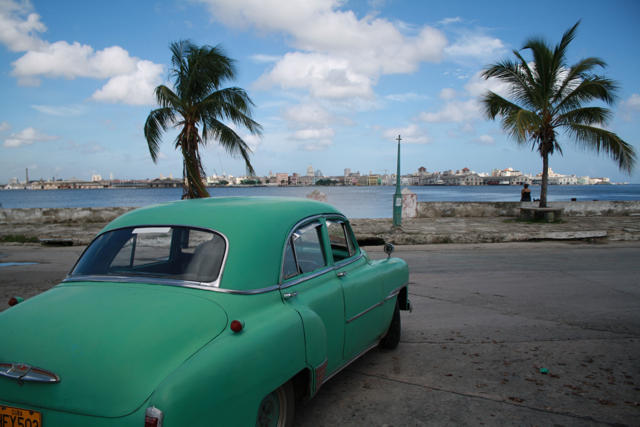
I returned to Regla and Iyalocha Lourdes performed another divination with cowrie shells to confirm that purification was necessary. It was. According to her, she needed to expel a spirit who was following me around and bothering me. She said the spirit belonged to a man I knew who died a long time ago. I tried and tried, but I couldn’t think of anyone who it might possibly be. Regardless, I figured it was best to expel it anyway… just in case.
Before Iyalocha Lourdes performed the purification ritual, I conducted the interview:
How long have you been a santera? Since I was six years old
How old are you? 50
Do you have other family members that practice Santería? All of them
You’re an “Iyalocha,” this means that you’ve initiated other santeros, right?
Yes, it means mother of santeros
How many?
An average of 250 to 260 people, initiated in the “asiento” (seating) ceremony of Ocha, those who I’ve made santeros. As far as initiating people in the religion, giving them necklaces … many more. (She shows me a registry book filled with names that date back to 1992).
Women and men? Women and men, but in most cases, women.
Who taught you to read cards, tarot and cowrie shells?
A person is born with that gift, it is something you know, that comes with you. Later you can study and perfect this gift that is brought by nature.
Which orishas protect you?
All of them because I attend to all of them. I give them flowers and perform rituals and sacrifices for them. I throw parties for them on each date that each deity is celebrated.
Have you ever been possessed by an orisha?
Yes, of course.
Which one?
Yemayá. One is possessed by an orisha by that which is sacred. If I initiate you and I perform the seating ceremony, or Ocha, and in that ceremony it is revealed that your goddess or patron is Yemayá, you only get possessed or enter into trance with Yemayá, which is the saint that is in your head. You can’t be in a trance with Oshún, with Shangó, with Oyá… no.
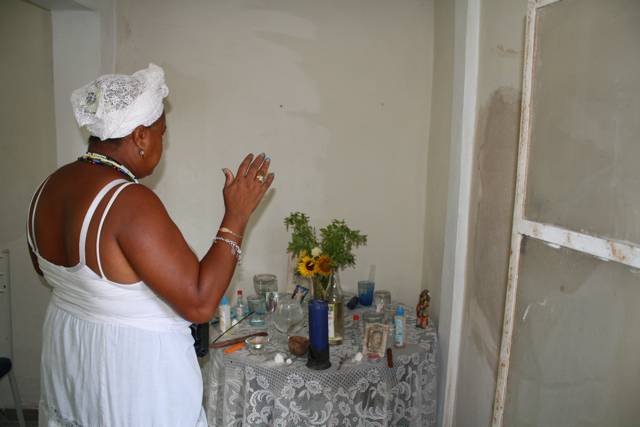
Just with Yemayá and San Lazaro, who is an orisha that comes to the head of any santero. If you’re aleyo – a person that participates in rituals but isn’t a santero – you can be in a trance with any orisha. That’s the big difference. The aleyo can receive the trance and the spiritual influence of any orisha. Initiated santeros can only receive this from their guardian angel or “seated” orisha.
Have you ever been possessed by a spirit?
Always. It’s the most common because it’s what spiritual practice does most often.
Do you remember what happens?
In the beginning you lose consciousness. It’s a process of spiritual development. Right now you’re an embryon – a person that doesn’t have the potential or capability to be a medium. Right now, that’s you – you don’t have any knowledge. You come to my temple to develop yourself spiritually, which means to process and open yourself and become a spiritualist. So, in the beginning, I pull the spirits so that they possess you. You lose consciousness, you don’t remember anything.
As the years go by, and you continue perfecting and working more with your spirituality, a moment will come when you’re seated, like I am, and a spirit comes to you and you speak, sometimes also in a conscious state and you can remember it. But this comes with practice.
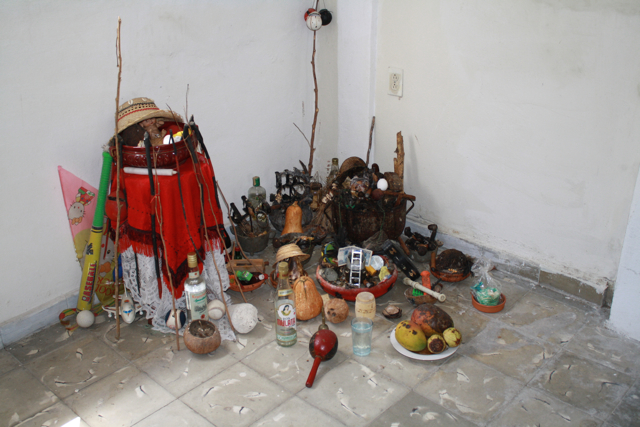
In the beginning there are people who are in a process of learning and development, and the spirits can drop them to the ground, throw them on the floor, hit them… It’s desperate, because when the spirit comes, they arrive to you and manifest themselves in the same way they died. For example, if they died tragically, you’re going to feel the things that happened to that person in your body, as if they’re happening, so a lot of people get afraid. They feel pain – if the person died very painfully, it’s possible that you could feel that.
How old were you the first time it happened? Twelve
How has Santeria changed since you began to practice it?
It hasn’t changed because we maintain the essence, the secrets, the values of the rituals. But, in a general sense … a lot of people have taken the religion down an incorrect path. They don’t do things the way our ancestors did, the way things are written, the way rituals should be performed. They step out of the boundaries and do things that demoralize the religion. There are people that now, to earn two or three dollars, they’ll tell you, “We’re going to do a misa (seance) ,” and they don’t have any spirit there and they mimic. And they don’t have anything, so they’re false spiritualists. But these are people that degrade the religion and commit atrocities.
Some people think that Santeria is more of a business than a religion, and it’s true that some santeros just do it for the money. How can one know if a santero is real?
The first piece of advice I will give you is to study and learn about the religion and you will know. Prepare yourself and with the intuition that you will develop, you will be able to tell. I, for example, know when we’re in a misa if someone is faking it because I’m able to receive, because I’m prepared. I know if you’re in a trance, if spirits are really coming to you because I also feel them in my body. So I can say, “Yes, there’s a spirit there with her.”
A lot of people criticize the animal sacrifices that are performed in Santeria, even people who eat meat or use animal products. Why do you think there is so much criticism against it?
Because there are people who think of the poor animals and they don’t want to kill animals, but the truth is that it’s an endless chain. One is nourished from the other, and to survive we have to eat. And to eat, you don’t kill it, but in the meat market, someone has killed it.
Do you think this comes from a lack of understanding of the Yoruba culture, from racism or something else?
No, it comes from a lack of understanding and from distorted concepts from the negative things people do who demoralize the religion. Because I perform a ritual, but when rituals require animal sacrifices you have to ask the orishas if you should cook and consume and serve that animal to the participants. The orisha says if you can eat it or not … if you’re very sick and you have to be purified, the animal that was used for the sacrifice cannot be given to other people to eat because it’s negative.

That negativity is passed to the animal and thrown out … Blood is a vital element. It carries oxygen throughout our entire bodies and, in a way, allows us to live, because the oxygen that’s transported in our blood goes to our lungs and lets us breathe and it goes to the brain and allows us to live. Blood, in religion, is the restorative element that gives life and allows the saints to grow and live, just as it moves our bodies. It’s important. There are rituals when they drink the blood of the animals.
(I interrupt) Have you drunk the blood of an animal?
Yes … Not all rituals are the same.
From what I’ve learned about Santeria, santeros should have the intention of restoring the balance of ashé (luck or power) and using it for good; they should never use Santeria to cause anyone harm. Have you known any santeros who used Santeria with bad intentions?
Yes, there are a lot. They’re vindictive and a lot of them are envious. If they see that a santera has a lot of people coming for consultations, they feel envious and begin to do harmful things. They start to put brujerías (curses) in people’s doorways and do things so that your husband leaves you, so that you lose your job, and things like that, which have to end.
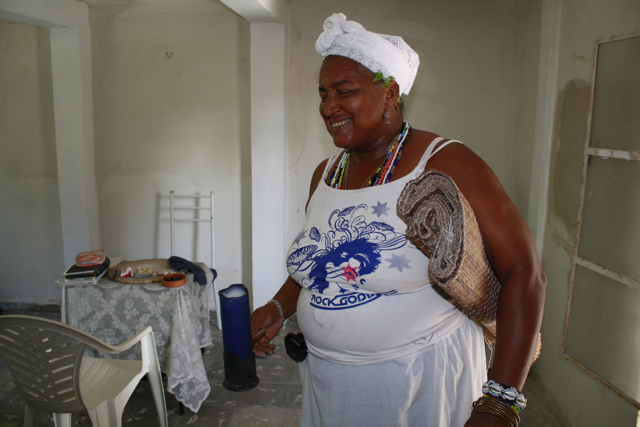
Every person, before entering the religion, should read books, learn and study so that they don’t get cheated. So that when they sit there they know (she motions to my chair), like now when you said to me that there are 16 cowrie shells, and you knew. You know it’s real. If you go somewhere and they toss cowrie shells and there are only ten, you know that they’re false. Because there aren’t ten, there are 16. You have to learn.
In Santeria, women cannot “make ifá” or become babalaos… (she interrupts me)
Well, that’s something else. That’s another religion. That’s Yoruba but it pertains to the rein of Ifá, which corresponds to men, for the simple reason that in the time that religion was created, a woman divulged the secret and it was taboo for that religion and so women were taken out and excluded from that ritual.
I thought that babalaos were the highest priests in Santeria…
The babalao is something else. It’s a hierarchy in the rein of Ifá. In Santeria, the babalao comes to perform small rituals, nothing more. For example, the killing of animals. They have that power in Santeria. Babalaos don’t initiate santeros, they’re not iyalochas, they’re babalaos. They only give to Orula, Olokun, San Lazaro… they have specific saints that they give to and consult with another method.
Do they use cowrie shells?
No, cowrie shells are used by santeros. Because of that, they don’t work with cowrie shells. A chain of coconut or nut shells are what they use to predict. They have two hundred and some signs…
Do you think this exclusion of women in making ifá is sexist?
No, not at all. Women don’t make ifá, they shouldn’t make ifá… women are excluded from certain rituals because of menstruation. But they do receive cofa de Orula. I have it, I’ve participated in that ritual with babalaos. I have cofa do Orula, which is the color yellow and green. What I can’t do is make ifá because it’s not permitted. When you read more, you’ll learn why I tell you this. I’m not going to reveal secrets.
So you don’t believe this will ever change in the future?
It can’t change because they’re established rules, and the religion consists of passing on the same concepts from one generation to another so that it maintains its essence. Although they say there are women babalaos, very old ones, they’re not babalaos, they receive another name. But it’s not the ceremony of making babalao- they’re called “servants of Orula,” who is Ifá. My husband is a babalao and I attend to the service of Orula.
Can you divine something for the future of Cuba, the country?
Why not. Good things and negative things that can be changed in order to be good and beneficial for everyone.
Can you tell something?
No, I haven’t done it because I mostly dedicate myself to work with each person.
Ok, but it is possible?
On December 31st and January 1st of each year I meet with the Yoruba Association of Cuba, an association of all the santeros. It concerns advice for the state, and the directive of the association is to perform rituals. Sacrifices are made to the orishas and all of it is for the well-being of our country, for the future, so that things turn out well. They cast a “letra,” which pertains to Cuba and the entire world. You’ll have to come another day so that I can explain more of this to you.
——-
THE PURIFICATION RITUAL
After the interview, Iyalocha Lourdes instructed me to leave my camera in the attic, where she performed the readings, and led me downstairs and outside to a small chamber in the back of the house. “This is palo (Afro-Cuban of Congo origin),” she said as she opened the door to the dark room. A chill ran down my spine.
According to Raul Canizares, author of Cuban Santeria: Walking With the Night, an excellent book I recently read on Santeria, “Palo exhibits a good/evil duality that does not exist in Santeria; a palero will deliberately choose to do evil, whereas the actions of a santero may have an unfortunate outcome but are carried out with the intention of balancing ashé.”
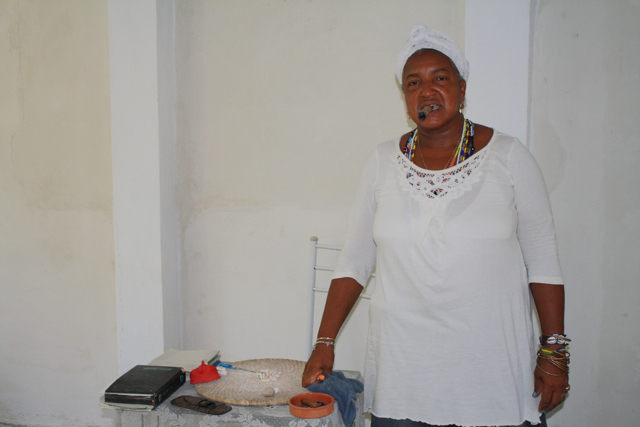
Although Iyalocha Lourdes seemed to be genuinely interested in helping me, I couldn’t get this definition of palo out of my head. A skull sat atop a heap of offerings in the center of the altar. Iyalocha Lourdes closed her eyes and began speaking in a language I didn’t recognize.
During the ritual, she struck me with a bunch of herbal leaves, used a variety of potions and incense and continued chanting. At one point, she took a swig of what appeared to be an infusion of herbs and rum and advised me to close my eyes. She then spit the infused rum all over my face and the rest of my body.
When the ritual ended, we walked inside and returned to the attic. Iyalocha Lourdes performed a small purification ritual in front of a white, round table filled with offerings and then cast coconut shells – also known as obi divination – to see if any further work was needed. Two of the shells landed with the dark skin up and the other two with the white, pulpy skin landed on top of each other (it appeared the coconut meat was gone and the shells had been marked with a white crayon). Iyalocha Lourdes informed me that this was a very good sign. “If they had landed the other way, with the two dark-skinned shells on top of each other, I would have had to sacrifice a chicken,” she said. I sighed with relief.
We then went downstairs so she could wash my Yemayá necklace in an herbal infusion. When it was ready, she donned the blue and white beads around my neck and smiled. “How do you feel now?” she asked. “I feel good,” I replied truthfully, although I didn’t notice anything strikingly different. “You probably feel as if you’re freshly bathed,” she said to me. I was looking forward to a shower once I got home, but I smiled and nodded anyway. There was one more thing I had to do.
Before I left Regla, I was instructed to take the two plastic bags filled with the used herbs and negative energy – apparently that of the pestering spirit – and toss them near the sea. On my way to the pier, I descended the bank of the sea and stood near several fisherman with the bags in hand. I felt a bit silly and I especially didn’t want to litter, but I took a deep breath, made the sign of the cross and tossed the bags into a pile of brujerías near the sea… just in case.






Hi. I enjoyed reading your story. Along the lines of reading, I wanted to get in contact with you. I am also interested in this subject. Do you have any information on the women . If so please let me know
Incredible interview, I had to do what you did. I believe it saved my life once. I was in a terrible accident at 31. few years later where i almost lost my right leg. After surgeries and nearly two months in the hospital I thought about the ritual and no longer regret doing it after that. I had to sacrifice a rooster which I helled by it’s poor twitching feet. I realized my fate was serious. After that things continue to happen that I was read about. Well, I’m walking perfectly fine. Have ugly scars belong my knee and can’t run but it didn’t stop me from getting married at 32. I believe my godfather who has his orishas was envolved. He is a very jealous vindictive person. He discovered I had a medium gifts through his palero and that’s why I believe I want for to stop growing spiritually. I am going into ministry soon and believe he paid someone to curse me when I was 24. Become around this time he wanted me to see a palero friend of his who the next day his wife told me to be careful with my godparents. She told me she didn’t especially trust my godmother who had to do works to literally get rid of her. Few years later a dog of mine died the same way she did and I believe it was his doing to get even. Ppl don’t realize that Yoruba is real and like the ifa told you, you won’t start to believe until you gain experience.
Thanks for sharing your story..and in reading your article I came across my next book to read, cuban Santeria: walking with night. Thank you. I too am familiar with the reglion I think it is quit facinating and special.
Excellent aricle Kelly. You seem to be “settling in” to your cuban adventure. Good for you, keep up the good work.